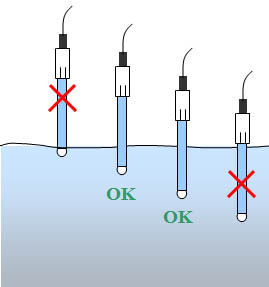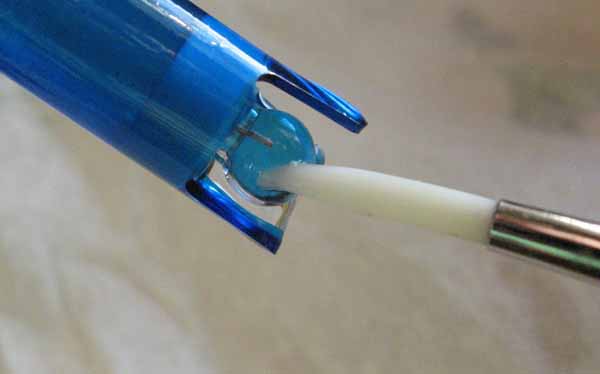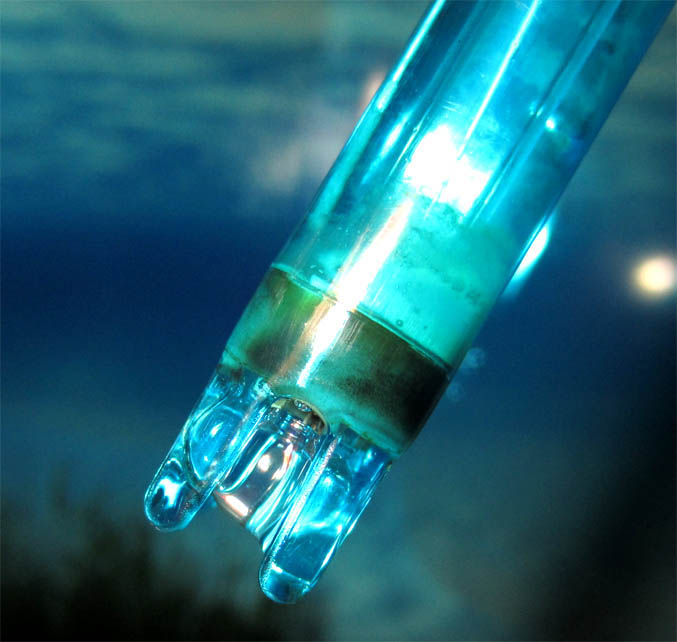|
|
Care and Storage of a pH Electrode pH electrodes do not last forever! The life of your pH electrode is not infinite. A number of factors affect the life span of your pH electrode. The higher the temperature that the electrode is used at, the more extreme the pH, how often the bulb dries out and needs to be rehydrated, how roughly it is used; all these factors and more shorten the life span of your electrode. An electrode that is well maintained and cared for can last up to 2 years, one that is not well maintained will not last as long, and one that is well maintained will not last significantly longer. Quick links: Placement pH elctrode and algea Why you need to calibrate pH Electrode replacement Never store an electrode dry Regeneration of pH glass electrodes Buy a new elctrode Placement 
pH elctrode and algea The probe should be cleaned and recalibrated periodically. Use a paint brush (soft brush) to gently clean the delicate probe tip at each water change. A soft toothbrush works also very well. Don't ever let the probe tip dry out! This is most likely to happen during water changes. 
Do NOT use sharp tools, abrasive materials, or cleaning powder. Why you need to calibrate The characteristic of a pH electrode will change with time due to electrode coating, contamination and aging. And even a pH electrode would be stable over time, pH electrodes cannot be produced with identical characteristics. In practice the response of a real pH sensor does not exactly follow the Nernst equation. This difference between the theoretical and actual behavior of a pH electrode must be compensated for. A calibration is required to match the pH meter to the current characteristics of the used pH sensor. pH Electrode replacement The pH electrode below has been used for long time and the contamination will result in a sluggish or non-responsive electrode because your electrode doesn't deliver the right electrical potential. There is algea penetrating the electrode (dark area) and KCl crystals (white) inside the electrode. It is about time to replace the unit with a new fresh electrode. 
Never store an electrode dry pH glass electrodes need to be kept moist at all times. If an electrode dries out during storage, a regeneration procedure is required to restore the hydrated glass layer and the reference junction in order to make the electrode operable. The pH electrode bulb needs to be moist at all times. When you are done with the electrode pour electrode storage solution into the cap that came with the electrode and put the cap over the bulb of the electrode. Keep the cap on until next use. If the electrode is being stored for a long time you may want to check the cap to be sure the storage solution is still in the cap and keeping the bulb moist. DO NOT STORE THE pH ELECTRODE IN DISTILLED WATER. Storing the pH electrode in distilled water will shorten the life of your pH electrode. If you do not have electrode storage solution use pH 4 buffer solution. If you have neither electrode storage solution or pH 4 buffer solution you can use pH 7 buffer solution for a short time. Regeneration of pH glass electrodes The pH glass membrane, the probe tip, is the sensitive part of your
electrode. If the glass membrane dries out during storage and sometimes
after a rough cleaning procedure gets damaged, you need to restore the hydrated glass layer. Below are suggestions for three different regeneration methods you can
use. The first method is the easiest to handle and the third method is
the most powerful. Regeneration method 1
Regeneration method 2
Regeneration method 3Manufacturers
of pH electrodes usually sell their special solution for regeneration
of glass electrodes. An example of a regeneration solution is a mixture
of hydrochloric acid (HCl) and hydrofluoric acid (HF). For the
appropriate procedure, see the instruction manual for the regeneration
solution.
Be careful when handling a reactivation solution. It is very toxic and aggressive to clothing, skin, and especially eyes. Ready to be usedIf your regeneration procedure has been successful, your electrode is now ready for calibration and measurement. We offer new pH electrode in our shop and you can also find calibration solutions there. You can always contact us if you need help with your pH electrode and calibration. |
|